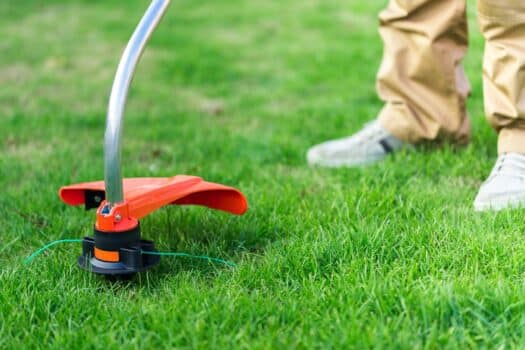Simple, powerful, yet a bit noisy– a 2-cycle weed eater is an excellent choice for small yards. But for yards with thick grasses and shrubs, a 4-cycle weed eater will be ideal, but you’ll have to spend a few extra bucks.
Cutting weeds, grasses, or small shrubs – the best 4-cycle weed eater helps you maintain a neat edge.
But despite its increased fuel efficiency, fewer emissions, and extra torque, many homeowners are turning to 2-cycle weed eaters. And rightly so, since 2-cycle units are lightweight, require less maintenance, and are easy on the pockets.
So, which one should you opt for– a 2-cycle or 4-cycle unit? If you cannot decide, read this guide to know the answer.
Difference Between 2-Cycle And 4-Cycle Weed Eater

Both 2-cycle and 4-cycle engines are also known as two-stroke and four-stroke engines. Contrary to popular opinion, these types of engines aren’t limited to weed eaters. In fact, they are used in edger, chainsaws, and other gas-powered lawn tools.
To decide which one would be the right pick, every gardening enthusiast needs to know the working of each unit.
From power output to maneuverability, the two differ from each other in a variety of aspects. For instance, a 2-cycle engine generates power after every two strokes, while a 4-cycle weed eater requires four strokes.
That said, we’ll walk you through the features of each weed eater so that you can figure out which one would be a perfect addition to the toolshed.
What Is A 2-Cycle Weed Eater?
A 2-cycle engine, often referred to as a two-stroke engine, runs on gasoline and specially formulated oil, usually in a ratio of 50:1 or 20:1.
Equipped with a piston, connecting rod, and a crankshaft, it requires only one power stroke to generate energy, emit exhaust, draw air and condense it. On the downward stroke or when the piston goes down, power is generated, and exhaust is emitted. And the moment the piston is moved upwards (upward stroke), the air is drawn and compressed.
As a two-cycle engine does the job in two strokes, it is much more powerful than its counterparts.
What Is A 4-Cycle Weed Eater?
Contrary to a two-cycle one, four-cycle engines consist of several parts– a piston, multiple valves, lifters, connecting rods, a camshaft, and a crankshaft. Instead of one revolution, a four-cycle engine completes four basic stages in two revolutions– hence, the name 4-cycle weed eater.
Typically, the four strokes of a four-cycle engine to complete one operation are as follows:
- Intake
- Compression
- Power
- Exhaust
Simply put, a four-cycle engine is similar to engines that are equipped in a car. In such engines, an oil distribution system and crankshaft work in tandem to separate oil from gas while lubricating the components of the engine.
And since the oil is separate, users must change it regularly– precisely after every 25 hours.
Best of all is that four-cycle engines require vehicle gas to operate, so you won’t have to stock any specialized fuel for trimming your driveways, pathways, and flowerbeds. While it’s safe to use gas with 10% ethanol, you must never use E85 gas because it is incompatible with a four-cycle engine.
Four Reasons Why You Should Prefer A 2-Cycle Weed Eater Over A 4-Cycle One
In some areas, a 2-cycle weed eater is certainly a notch above a 4-cycle one. Dive in to explore the areas where the former outperforms the latter.
1. Power
When it comes to power, both four-stroke and two-stroke engines use similar fuels to generate power. Not just that, but they are also equipped with the same engine size; even then, two-cycle engines generate more raw power compared to four-cycle ones.
Certainly, it’s surprising, but the reason behind the extra power is that a two-cycle trimmer uses only two strokes to produce power. Therefore, it has less work to do, which is why it can generate more power than a four-cycle engine.
As four-cycle trimmers require two power strokes to generate power, they cannot produce as much power as two-cycle ones.
2. Fewer Moving Parts
Two-cycle engines aren’t as complicated as four-cycle units because they have few parts. A machine with fewer parts is much more efficient than those with more parts.
On the other hand, a four-cycle engine is manufactured with extra parts because it has to go through four stages to operate. Whenever layers of complexity are added, there’s a high possibility that the unit will need more maintenance and will have to fix whenever it breaks down.
3. Weight
The weight of a string trimmer may not be of much importance to professionals, but it’s an important factor for homeowners.
Any machine that is too heavy will hamper productivity and put a strain on your hand. This means you won’t be able to work for longer hours, which will be a problem for gardening enthusiasts who have to trim a large lawn.
A 2-cycle engine weighs less because it isn’t equipped with complex components against its four-cycle counterpart. Owing to fewer parts, a two-cycle engine produces less vibrations, which adds to its user-friendliness. Thus, you won’t have to exert too much pressure while using a weed eater equipped with it.
4. Cost
Another area where a two-cycle engine cuts above a four-cycle unit is price. While the former is reasonably priced, the latter is slightly expensive.
That’s because two-stroke engines are built with fewer moving parts, so the production cost is less. Meanwhile, four-cycle engines are equipped with a few extra parts that increase the cost of production. For this reason, homeowners will have to spend a tad bit on adding a four-cycle engine to their toolshed.
But for those on a budget, look no further than a two-cycle engine for it is affordable.
Five Reasons Why A 4-Cycle Weed Eater Is A Cut Above A 2-Cycle Unit
If you’re under the impression that a 2-cycle weed eater is better than a 4-cycle one, you’re wrong! There are certain areas where a four-cycle weed eater outshines its two-cycle counterparts.
Without further delay, let’s explore the areas where a 4-cycle unit emerges superior to a 2-cycle weed eater.
1. Fuel Efficiency
One of the perks of owning a 4-cycle weed eater is that it is more fuel efficient than a 2-cycle unit.
Although a two-stroke engine produces more power, it burns more fuel than expected. Furthermore, exhaust gases aren’t completely released in a 2-cycle engine. On top of that, a considerable amount of gas mix is released via exhaust without generating power.
Conversely, a 4-cycle engine is fuel efficient because it consumes less fuel, which is why most homeowners prefer investing in it.
2. Gas And Oil Mix
Gas and oil are needed to lubricate the engine of both a 2-cycle engine and a 4-cycle one. However, the difference lies in the way the two fossil fuels are stored in two and four-stroke engines.
In a 4-cycle engine, there are separate chambers for storing gas and oil to lubricate the engine. So, as long as you keep the oil tank full, the engine will lubricate itself whenever you use it to trim the lawn.
Unfortunately, a 2-cycle engine isn’t capable of self-lubricating the engine during operation. As against a 4-cycle engine, it doesn’t have separate compartments for oil and gasoline. Instead, you’ll have to mix oil with gasoline at a ratio of 1:50– one part of engine oil and 50 parts of gasoline.
However, the ratio may vary from model to model, so it’s best to refer to the manufacturer’s guide before mixing oil and gasoline.
Of course, this is confusing, and even the slightest mistake can lead to a lot of trouble. For this reason, a weed eater with a 4-stroke engine has the edge over a 2-stroke engine. You just need to add the fuels to their respective compartments and need not worry about mixing them in the correct ratio.
Now the question is– can you use motor oil in a weed eater? Of course, not! Not many know that boat or automotive engine oil can damage the engine of your device, and that’s why the brand Weed Eater advises customers to refrain from using them. Poulan or Poulan Pro, Paramount, and Weed Eater are some brands whose oil you can consider for your 2-stroke or 4-stroke engine string trimmers.
3. Pollution
None of the two units are environmentally-friendly, but a 4-stroke engine emits less fumes. What makes the two non-eco-friendly is that both use gasoline to create power and contaminate the air with exhaust fumes.
However, when it comes to pollution, a 4-cycle engine is superior to a 2-cycle unit because it burns only oil, not gas, thanks to the separate compartments for storing them. Also, it doesn’t emit as much black fog as a 2-cycle weed eater, so you won’t have to worry about inhaling any nasty fumes.
4. Noise
Prefer a weed eater that won’t disturb your neighbors with its loud noise? In that case, a 4-cycle weed eater will be the best bet because it is quieter than its two-cycle counterparts.
Whenever a downward stroke is made in a 2-cycle weed eater, both power and combustion happen, and on every second stroke, intake and exhaust take place. Similar things happen on a 4-cycle weed eater, but on the third stroke, combustion occurs within the engine, because of which the unit doesn’t make much noise.
5. More Torque
When it comes to torque, there’s no denying that a 4-cycle weed eater cuts above a 2-cycle unit. In simple words, torque means the force that generates power within the engine to make the blades spin around an axis.
As a 4-cycle engine operates at a higher RPM (revolutions per minute), it cuts through the grasses, weeds, and small shrubs more efficiently than a 2-cycle weed eater. For thick patches of grass, greater torque is required, which is offered by a 4-cycle weed eater. While you can go for a 2-cycle weed eater, remember that you’ll have to work a little hard to trim the lawn.
With a 4-cycle weed eater, you’ll be able to cut through the grass quickly, and it will also reduce operator fatigue.
2-Cycle Weed Eater Or 4-Cycle Weed Eater– How To Choose The Right One For Your Lawn?

Deciding which of the two weed eaters will be the right pick for keeping your lawn healthy isn’t as easy as it may sound. To save you some hassle, we’ve put together a few important factors that will help you choose the right one between a 2-cycle and a 4-cycle weed eater.
So, let’s check them out.
1. Size Of Your Lawn
Before spending money on any weed eater, you need to consider the size of your lawn. A large yard will need a device that generates greater torque so that you can trim the weeds, grasses, and shrubs quickly.
For a small or medium-sized lawn, a 2-cycle weed eater would be the best bet. However, a 4-cycle engine is ideal for a large or an overly large lawn.
2. Type Of Grass
For a lawn full of thick grasses or shrubs, homeowners will need a powerful device that can go through it without any difficulty. So, they can go for a 4-cycle weed eater because it will trim them in a breeze. But, if the grasses of your lawn aren’t thick, you can go for a 2-cycle weed eater.
3. Weight
Lightweight weed eaters allow you to trim the lawn for hours without experiencing hand fatigue as against heavy devices.
So, if you’re looking for a lightweight weed eater, a 2-cycle weed eater is the best choice. But for professionals, a 4-cycle weed eater will be the right pick because of its functionality and versatility.
4. Price
Last but not least, the price of a weed eater plays a crucial role in the decision-making process. We’ve already mentioned that a 2-cycle weed eater is affordable, but a 4-cycle unit is costly.
For gardening enthusiasts and people on a budget, you must go for a 2-cycle weed eater. But, if you don’t mind spending a few bucks more on a weed eater, a 4-cycle unit will be perfect for your needs.
Difference Between 2 Cycle And 4 Cycle Weed Eater Frequently Asked Questions ?
How much gas does a weed eater use per hour?
Often, homeowners wonder– how much gas does a weed eater use per hour. If you’re wondering the same, let us tell you that about ¼ gallon of gas or oil mixture is used per hour to trim weeds, grasses, shrubs, and flowerbeds.
Are 2-cycle weed eaters louder than 4-cycle weed eaters?
Yes, a 2-cycle engine produces more noise than a 4-cycle one. That’s because it completes the process in two strokes, while a 4-cycle weed eater requires four strokes to complete one revolution.
At what ratio should gas and oil be mixed in a 2-cycle weed eater?
Ideally, gas and oil are mixed at a ratio of 40:1 with one gallon of gasoline and 3.2 ounces of engine oil. However, you must refer to the manufacturer’s manual before mixing gas and oil to be on the safe side.

Difference Between 2 Cycle And 4 Cycle Weed Eater Wrapping It Up
Now that you know everything about the two weed eaters, which one are you planning to go for?
For small lawns, 2-cycle weed eaters will be perfect because they are lightweight, cut through weeds and grasses efficiently, and don’t cost a fortune. But for thick grasses and large-sized lawns, 4-cycle weed eaters are ideal. However, they are slightly costlier, so you’ll have to fork out extra cash to add them to your garden tool shed.
Well, that brings us to the end of our guide on the topic. Hopefully, you’ll choose the right one for your lawn.
Toodles!


